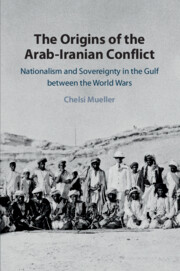Refine search
Actions for selected content:
15418 results in Military history
Maps
-
- Book:
- The Origins of the Arab-Iranian Conflict
- Published online:
- 24 July 2020
- Print publication:
- 13 August 2020, pp xii-xiii
-
- Chapter
- Export citation
6 - Bahrain, Iran, and the British
-
- Book:
- The Origins of the Arab-Iranian Conflict
- Published online:
- 24 July 2020
- Print publication:
- 13 August 2020, pp 191-228
-
- Chapter
- Export citation
Chronology of Major Events
-
- Book:
- The Origins of the Arab-Iranian Conflict
- Published online:
- 24 July 2020
- Print publication:
- 13 August 2020, pp xiv-xvi
-
- Chapter
- Export citation
Appendix D: - Al Khalifa Rulers of Bahrain
- from Appendices
-
- Book:
- The Origins of the Arab-Iranian Conflict
- Published online:
- 24 July 2020
- Print publication:
- 13 August 2020, pp 248-248
-
- Chapter
- Export citation
1 - States and Tribes in the Premodern Gulf
-
- Book:
- The Origins of the Arab-Iranian Conflict
- Published online:
- 24 July 2020
- Print publication:
- 13 August 2020, pp 8-45
-
- Chapter
- Export citation
Appendix B: - Iranian Officials
- from Appendices
-
- Book:
- The Origins of the Arab-Iranian Conflict
- Published online:
- 24 July 2020
- Print publication:
- 13 August 2020, pp 244-246
-
- Chapter
- Export citation
Index
-
- Book:
- The Origins of the Arab-Iranian Conflict
- Published online:
- 24 July 2020
- Print publication:
- 13 August 2020, pp 264-274
-
- Chapter
- Export citation
Contents
-
- Book:
- The Origins of the Arab-Iranian Conflict
- Published online:
- 24 July 2020
- Print publication:
- 13 August 2020, pp v-v
-
- Chapter
- Export citation
Appendices
-
- Book:
- The Origins of the Arab-Iranian Conflict
- Published online:
- 24 July 2020
- Print publication:
- 13 August 2020, pp 242-248
-
- Chapter
- Export citation
Maps and Figures
-
- Book:
- The Origins of the Arab-Iranian Conflict
- Published online:
- 24 July 2020
- Print publication:
- 13 August 2020, pp vi-vi
-
- Chapter
- Export citation
2 - British Policy in the Persian Gulf between the World Wars
-
- Book:
- The Origins of the Arab-Iranian Conflict
- Published online:
- 24 July 2020
- Print publication:
- 13 August 2020, pp 46-77
-
- Chapter
- Export citation
Transliteration, Terms, and Conventions
-
- Book:
- The Origins of the Arab-Iranian Conflict
- Published online:
- 24 July 2020
- Print publication:
- 13 August 2020, pp ix-xi
-
- Chapter
- Export citation

The Origins of the Arab-Iranian Conflict
- Nationalism and Sovereignty in the Gulf between the World Wars
-
- Published online:
- 24 July 2020
- Print publication:
- 13 August 2020
Illustrations
-
- Book:
- The Hunger Winter
- Published online:
- 04 July 2020
- Print publication:
- 23 July 2020, pp viii-ix
-
- Chapter
- Export citation
Acknowledgements
-
- Book:
- The Hunger Winter
- Published online:
- 04 July 2020
- Print publication:
- 23 July 2020, pp xiii-xv
-
- Chapter
- Export citation
3 - Effects on Mortality, Fertility, and Health in Later Life
-
- Book:
- The Hunger Winter
- Published online:
- 04 July 2020
- Print publication:
- 23 July 2020, pp 60-90
-
- Chapter
- Export citation
Contents
-
- Book:
- The Hunger Winter
- Published online:
- 04 July 2020
- Print publication:
- 23 July 2020, pp vii-vii
-
- Chapter
- Export citation
8 - The Evacuation of Children
-
- Book:
- The Hunger Winter
- Published online:
- 04 July 2020
- Print publication:
- 23 July 2020, pp 231-256
-
- Chapter
- Export citation
Abbreviations
-
- Book:
- The Hunger Winter
- Published online:
- 04 July 2020
- Print publication:
- 23 July 2020, pp xvi-xvii
-
- Chapter
- Export citation
Introduction
-
- Book:
- The Hunger Winter
- Published online:
- 04 July 2020
- Print publication:
- 23 July 2020, pp 1-16
-
- Chapter
-
- You have access
- HTML
- Export citation
